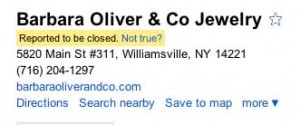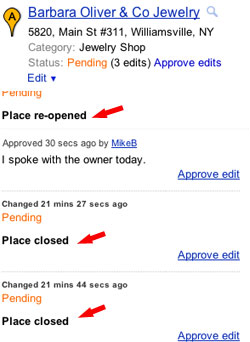 It seems that the newest blackhat playground of user generated input annoyance is the “Place is permanently closed” radio button in Google Places. I have been receiving an increasing number of complaints from readers that are seeing the flag. In fact Barbara Oliver Jewelry and Andrews Jewelers both experienced the dreaded yellow highlight on their Places Pages over the past week shortly after they were hit with competitor review spam. Apparently the flag is generated both by algo and humans but there appears to be an uptick in its use as competitors (and their blackhat proxies) face off in Places.
It seems that the newest blackhat playground of user generated input annoyance is the “Place is permanently closed” radio button in Google Places. I have been receiving an increasing number of complaints from readers that are seeing the flag. In fact Barbara Oliver Jewelry and Andrews Jewelers both experienced the dreaded yellow highlight on their Places Pages over the past week shortly after they were hit with competitor review spam. Apparently the flag is generated both by algo and humans but there appears to be an uptick in its use as competitors (and their blackhat proxies) face off in Places.
 Until Google steps in and either changes the procedure or eliminates the option, there is little to be done to prevent someone from repeatedly flagging your listing and bringing the flag to the fore. If they have access to multiple IPs it can occur multiple times in very short order. I presume if the status is left as is, the listing will eventually fall from the results although just the flag alone is likely to diminish user calls to a business.
Until Google steps in and either changes the procedure or eliminates the option, there is little to be done to prevent someone from repeatedly flagging your listing and bringing the flag to the fore. If they have access to multiple IPs it can occur multiple times in very short order. I presume if the status is left as is, the listing will eventually fall from the results although just the flag alone is likely to diminish user calls to a business.
The only current remedy is to keep an eye on your listing and as soon as the “Reported to be closed” flag appears report via the “Not True?” link while logged in as the owner of the listing that it is in fact open. Then immediately head over to MapMaker and approve your edit and the flag will instantly disappear. The problem is that a motivated spammer, using multiple IPs and sock puppets can keep you hopping and it isn’t clear that Google will automatically put an end to the tomfoolery.
Like community edits before, this problem demonstrates the vulnerability of a listing to blackhat spamming activities in the form of community input. It also dramatically points out why Places should offer every legitimate claimant an automated business owner feedback mechanism that alerts them to major changes to the listing and to new reviews. It gets old very quickly sitting vigil over a listing being repeatedly hit with this absurdity when Google could easily send out a notice on a claimed listing.

